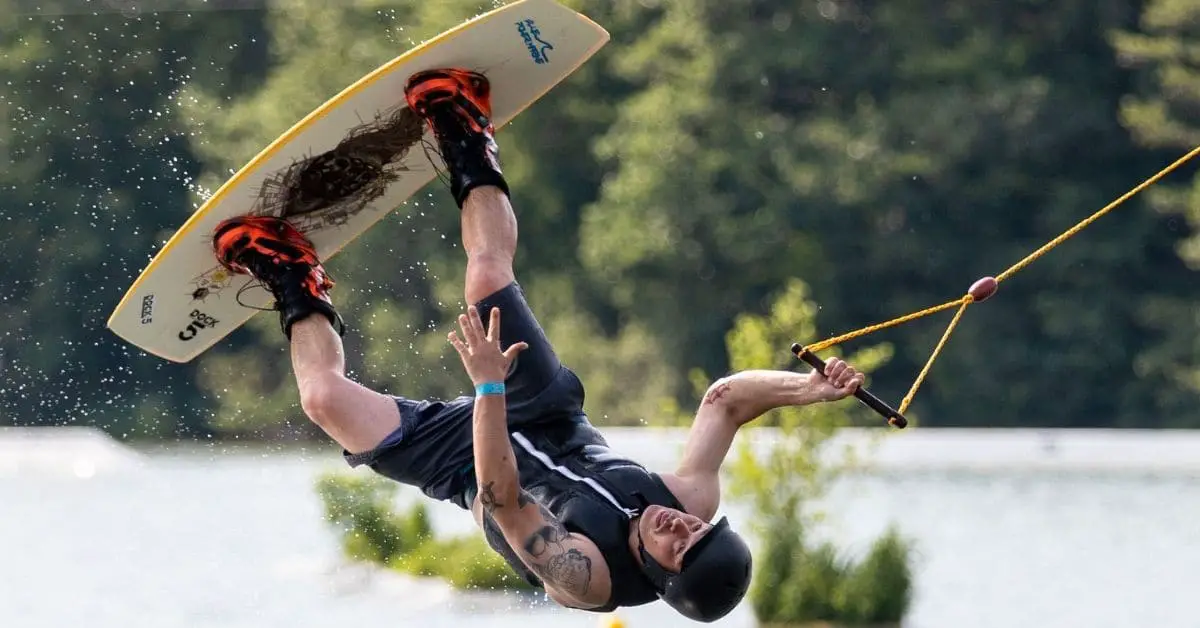Although very hard at first, wakeboarding is a lot of fun once you finally learn how. The fun never stops as you slowly get better and learn many tricks. What many people fail to realize though is the danger in wakeboarding.
A study from the U.S. National Library of Medicine showed that around 47.9% of wakeboarding injuries occurred around the neck or head area, which is much more than 24.6% that water skiing had. Although waterskiing did have slightly more injuries in general, it shows that wakeboarding injuries tend to be in much more dangerous spots.
This data leads us into our first safety tip:
1. Wear a helmet
Many people in the wakeboarding world will argue against this saying that it makes your head buoyant and more susceptible to whiplash and neck injury. Also, that the helmet could cause you to blow your eardrum because of the pocket that is created by there being no ear protection on most helmets.
And I agree on some of those points, and it totally could happen, but in my opinion, a sore neck or blown eardrum can heal, but damage to the brain cannot. this is why (especially if you fall hard a lot) I would recommend getting a helmet such as this one on Amazon. The good thing about that helmet is it has ear protection, so no need to worry about ruptured eardrums.
If your kid or you thinks their gonna look dumb wearing it, it’s really not. Many pros wear them and think about this. With a helmet, you will usually feel safer to shred harder, so if you want to improve at some crazy tricks your working on, might as well do it with a helmet.
2. Slowly work your way up with tricks
Yes, I know we all want to shred like the pros but dude ill bet you a million bucks you can’t do half the things they can. If your goal is to land a backflip and you’ve never done any other tricks before, just learn some easier stuff first.
Once you feel comfortable in the air, work on doing 180s and landing/riding goofy-footed before you try anything harder. I feel that’s the best starting trick that you can get down safely, and it’s not too difficult. I’d say once you can jump the wake doing that, then you can move on to bigger and better tricks.
3. Watch out for shallow water
After taking a hard fall, many times you get launched headfirst into the water. Shallow areas such as rock piles could be deadly to someone, especially if they aren’t wearing a helmet. I would recommend always stay in at least 10 feet of water (preferably where the bottom is sandy).
4. Always keep your knees slightly bent
Along with head injuries, wakeboarding is also known for posing risk to knee injuries as well. The best way to keep this from happening is to always have a slight bend in your knees.
5. Have common sense: (no alcohol, wear a life jacket that fits, have a spotter)
Most of these things are just common sense, but many people don’t do it. I can tell you right now that wakeboarding is already dangerous enough, there’s no reason to put alcohol in the mix. You’ll surely do something dumb and get injured.
6. If your too old, your too old
Wakeboarding is a pretty extreme sport that requires the rider to be in pretty good shape to succeed at doing it. I’m not saying that you cant do this if you old, but you need to make sure you’r in shape before trying it.
Don’t have wakeboarding be your first step to getting back in shape, it might not end so well.
- What Is The Cheapest Way To Store A Boat? - February 28, 2023
- Do Boats Need Bottom Paint? (Uncovering the Truth) - February 2, 2023
- How Much Is Bass Boat Insurance? (Real Quotes) - January 18, 2023

